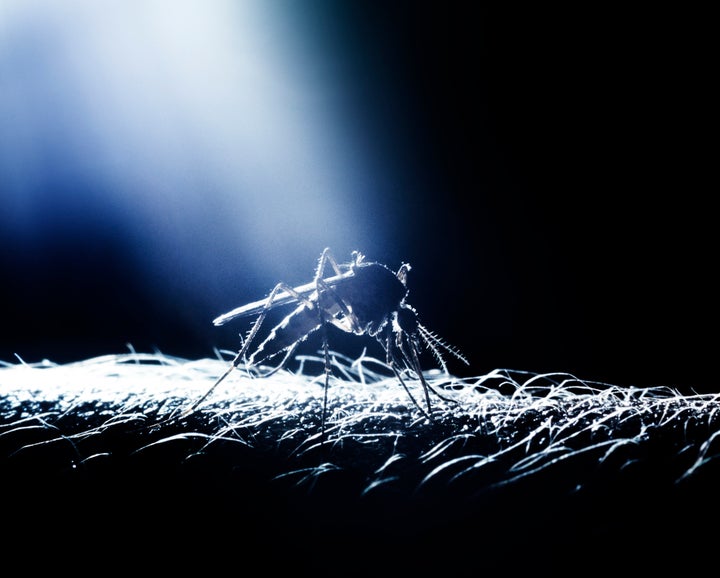
A group of doctors in Argentina calling themselves the "Physicians in Crop-Sprayed Towns" have issued an explosive report that denies global scientific consensus on the Zika virus outbreak and its apparent link to an uptick in cases of the birth defect microcephaly in Brazil.
The doctors allege that instead of the mild mosquito-borne Zika virus, the increase in microcephaly cases is caused by a larvicide that contains the chemical pyriproxyfen. This larvicide is employed in mosquito control efforts against the Aedes Aegypti mosquito, the type that can carry Zika, including using it to kill eggs in public water supplies.
Since its release on Feb. 3, the doctor's 6-page report has spread like wildfire across the Internet, first cropping up in news sites run by GMO and environmental watchdogs and then finding mainstream coverage in outlets like the U.K.’s Telegraph and the New York-based Tech Times. Even actor George Takei shared the story, garnering about 25,000 Facebook likes and almost as many shares.
There's one problem: the report is completely wrong.
Not only does the report convey inaccurate information about Zika virus’ history and speculate about the timetables of microcephaly cases and the use of the larvicide in water treatment, but it ends in a diatribe against other types of mosquito control efforts. Given the clear need for mosquito control to prevent further illnesses -- and not just Zika, but also dengue fever, chikungunya, and yellow fever -- this isn't just ill-conceived, it's actually dangerous.
"The effect of this [report] to cause panic in people, and to prevent an effective response to disease carrying-vectors, is a very substantial negative,” said Ian Musgrave, an expert on neurotoxicology and pharmacology at the University of Adelaide. "If they wanted to control the mosquitos, what are they going to use now? Something even more toxic?"
The report is having a real effect on the ground, too: Though the Brazilian government dismissed claims of a relationship between pyriproxyfen and microcephaly, at least one state in Brazil has already suspended its use. Dr. Francis Collins, director of the U.S. National Institutes of Health, spoke out against the "sketchy" report, reports the Wall Street journal, as did Dr. Anthony Fauci, director of the National Institute of Allergy and Infectious Diseases.
"The mistake is not the position against or in favor of the larvicide, but to insist in causal inferences without evidence," added Ligia Bahia, a public health expert at the Federal University of Rio de Janeiro who also took issue with the distraction the report poses from the real threat of Zika virus.
Here are five inconvenient truths that refute this viral report.
1. Pyriproxyfen is a very mild larvicide
Musgrave called the claims that pyriproxyfen causes microcephaly “simply not plausible.”
Musgrave, who has no ties to pyriproxyfen manufacturers, financial or otherwise, points out that pyriproxyfen is so mild that it has been used as a pesticide in tick and flea collars for pets for years. An adult human would have to eat a teaspoon of raw pesticide to be poisoned by the chemical, said Musgrave, and a person would have to drink over 1,000 liters of pyriproxyfen-treated water every day to feel any negative effects.
"Even enormous quantities of pyriproxyfen do not cause the defects seen during the recent Zika outbreak,” he said, adding that the pesticide is poorly absorbed by humans and rapidly broken down, so even the minute amounts humans would be exposed to via water treatment would be reduced even further.
“Even enormous quantities of pyriproxyfen do not cause the defects seen during the recent Zika outbreak."”
- Dr. Ian Musgrave, neurotoxicologist
2. The Zika virus-microcephaly connection is strong
Another inconvenient truth the report fails to mention is that there is mounting scientific evidence that implicates the Zika virus in microcephaly, a birth defect in which babies are born with smaller-than-usual heads and may experience developmental challenges. The World Health Organization says scientists are “weeks” away from confirming a causal link, and other researchers, including those with the U.S. Centers for Disease Control and Prevention, say the link is “strongly suspected."
The Argentinean doctors argued that Brazil is the only country that experienced a spike of microcephalic births in the midst of a Zika virus epidemic, but that isn’t true. Doctors in French Polynesia, a group of islands that experienced an 11 percent Zika virus infection rate in 2013, are examining the medical records of 17 cases of "central nervous system malformations" in fetuses and infants. Twelve of these fetuses had cerebral malformations, including brain lesions, and five babies had brainstem dysfunction and absence of swallowing. None of their mothers experienced Zika virus symptoms, but four did test positive for signs of flavivirus -- a group of viruses that includes Zika.
What's more, there are already lab studies that confirmed the presence of Zika virus in the blood, tissue, brains and amniotic fluid of fetuses and babies diagnosed with microcephaly. The most recent, and probably most disturbing, example of these studies was published last week in the New England Journal of Medicine. A woman who lived in Brazil during her first trimester of pregnancy confirmed, at 32 weeks, that the fetus she was carrying had severe microcephaly with calcifications in the brain and placenta.
In an autopsy of her fetus, doctors found that its brain was almost completely smooth, was collecting fluid, and showed calcification in many parts. They also found evidence of Zika virus in the brain tissue, but nowhere else in the fetus’ body. Other analyses suggested that the virus was able to hide and replicate in the fetus' brain, and that the damage this caused might have slowed development of the brain at around 20 weeks gestation.
3. It's too soon to compare Brazil and Colombia
The Argentinian group insists that the cause of microcephaly must be local to Brazil because Colombia has thousands of pregnant women with Zika virus and not one diagnosed case of microcephaly at birth or in the womb.
But that theory ignores an important timeline: Because the virus first hit Colombia in October, women who could have gotten Zika virus in their first month of pregnancy would only be about five months along right now. It generally takes about six months of pregnancy for a doctor to be able to diagnose microcephaly via ultrasound, reports The New York Times.
What's more, unlike Brazil, Colombia is allowing women with Zika virus to access abortion services. Indeed, one woman told the New York Times that she decided to end her pregnancy after her doctors detected a deformity in her ultrasound.
Only time will tell how Colombia’s babies will be affected by Zika virus, but making an evaluation now is hasty and doesn't align with scientists' understanding of microcephaly.
4. Of course regions with high microcephaly also have larvicide -- that's where the mosquitos are
Brazil’s microcephaly cases are strongly concentrated in the northeast region of the country, especially in the state Pernambuco. But that’s because, as the Argentinean doctors themselves note, this part of Brazil is impoverished, with “poor urbanisation and inadequate sanitation.” The lack of running water or a reliable sewage system forces families to store large amounts of water for domestic use in containers near the house, and those are perfect breeding areas for mosquitoes.
Those living conditions, in and of themselves, are why mosquitos proliferate in such areas, and why Pernambuco in particular has seen the highest rates of Zika virus infection and microcephaly, experts say.
Other states that don’t treat their water with the pesticide have also reported microcephaly cases, Brazil’s Ministry of Health noted.
5. Monsanto is not involved in the sale or manufacture of this larvicide
The report implicates the U.S.-based agribusiness giant Monsanto, a company regularly mentioned in online eco-conspiracy theories. But the truth is that Monsanto is not involved in any way in the sale or manufacture of pyriproxyfen, which is made by a Japanese manufacturer named Sumitomo Chemical. And though Sumitomo works with Monsanto on some crop-based projects, the companies are not linked on water treatment, Monsanto notes.
In a statement to the Wall Street Journal, Sumitomo similarly denounced the report linking its larvicide to microcephaly, pointing out that the World Health Organization has approved this chemical for mosquito control, and that it has been used in France, Denmark, Spain, Turkey, the Dominican Republic and Colombia.
Emotions are running high when it comes to Zika virus and its suspected link to serious birth defects like microcephaly. While alternate theories for the cause of the birth defects shouldn't be dismissed outright, they do need to be put through rigorous scientific inquiry.
